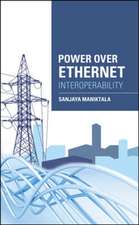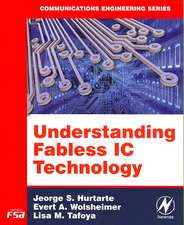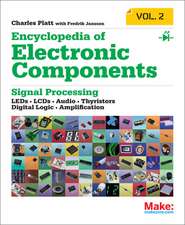Low-Power VLSI Circuits and Systems
Autor Ajit Palen Limba Engleză Hardback – 28 noi 2014
| Toate formatele și edițiile | Preț | Express |
|---|---|---|
| Paperback (1) | 395.63 lei 6-8 săpt. | |
| Springer India – 23 aug 2016 | 395.63 lei 6-8 săpt. | |
| Hardback (1) | 403.15 lei 6-8 săpt. | |
| Springer India – 28 noi 2014 | 403.15 lei 6-8 săpt. |
Preț: 403.15 lei
Nou
Puncte Express: 605
Preț estimativ în valută:
77.15€ • 83.78$ • 64.81£
77.15€ • 83.78$ • 64.81£
Carte tipărită la comandă
Livrare economică 23 aprilie-07 mai
Preluare comenzi: 021 569.72.76
Specificații
ISBN-13: 9788132219361
ISBN-10: 8132219368
Pagini: 389
Ilustrații: XXXVII, 389 p. 303 illus.
Dimensiuni: 155 x 235 x 28 mm
Greutate: 0.77 kg
Ediția:2015
Editura: Springer India
Colecția Springer
Locul publicării:New Delhi, India
ISBN-10: 8132219368
Pagini: 389
Ilustrații: XXXVII, 389 p. 303 illus.
Dimensiuni: 155 x 235 x 28 mm
Greutate: 0.77 kg
Ediția:2015
Editura: Springer India
Colecția Springer
Locul publicării:New Delhi, India
Public țintă
GraduateCuprins
Introduction.- MOS Fabrication Technology.- MOS Transistors.- MOS Inverters.- MOS Combinational Circuits.- Sources of Power Dissipation.- Supply Voltage Scaling for Low Power.- Switched Capacitance Minimization.- Leakage Power Minimization.- Adiabatic Logic Circuits.- Battery-Aware Systems.- Low Power Software Approaches.
Recenzii
“This book provides readers not only with succinct information for designing low-power very largescale integration (VLSI) circuits and systems, but also with fundamental VLSI design knowledge. It is intended to be used as a textbook for either an undergraduate or graduate course, although researchers and practicing engineers may also find it helpful.” (I-Lun Tseng, Computing Reviews, September, 2015)
Notă biografică
Ajit Pal is currently a Professor in the Department of Computer Science and Engineering at Indian Institute of Technology Kharagpur (IITKGP). He received his M.Tech. and Ph.D. degrees for the Institute of Radio Physics and Electronics from Calcutta University in 1971 and 1976, respectively. Before joining IITKGP in the year 1982, he served at Indian Statistical Institute (ISI), Calcutta; Indian Telephone Industries (ITI), Naini and Defense Electronics Research Laboratory (DLRL), Hyderabad in various capacities. He was designated professor in 1988 and served as Head of Computer Center from 1993 to 1995 and Head of the Computer Science and Engineering Department from 1995 to 1998. His research interests include embedded systems, low-power VLSI circuits, sensor networks and optical communication. He has served as the principal investigator of several sponsored research projects including ‘Low Power circuits’ sponsored by Intel, USA and ‘formal methods for power intent verification’, sponsored by Synopsis (India) Pvt. Ltd. He has over 150 publications in reputed journals and conference proceedings and three books entitled Microprocessors: Principles and Applications, Microcontrollers: Principles and Applications and Data Communication and Computer Networks. He is a Fellow of IETE, India and Senior Member of IEEE, USA.
Textul de pe ultima copertă
The book provides a comprehensive coverage of different aspects of low power circuit synthesis at various levels of design hierarchy; starting from the layout level to the system level. For a seamless understanding of the subject, basics of MOS circuits has been introduced at transistor, gate and circuit level; followed by various low-power design methodologies, such as supply voltage scaling, switched capacitance minimization techniques and leakage power minimization approaches. The content of this book will prove useful to students, researchers, as well as practicing engineers.
Caracteristici
Introduces fabrication and operation of CMOS circuits at transistor, gate and circuit level Discusses different aspects of low-power circuit synthesis at various levels of design hierarchy Includes realization of adiabatic switching circuits Presents battery-aware synthesis in view of the proliferation of battery-operated portable system Discusses software based approaches to achieve lower power dissipation Each chapter provides abstract and keywords in the beginning and ends with chapter summary, review questions and references to satisfy pedagogical requirements of a textbook Includes supplementary material: sn.pub/extras















